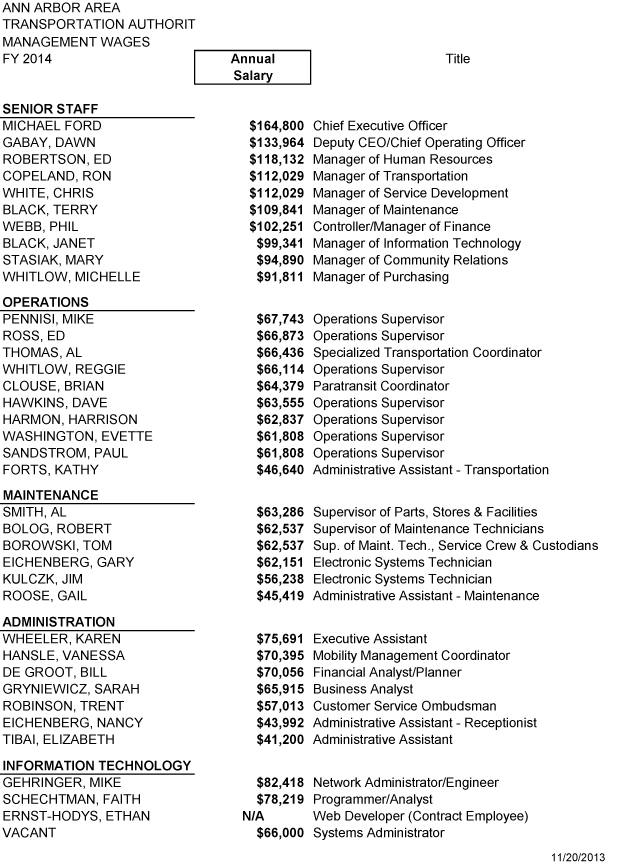AAATA CEO’s Salary Cut While Pay For Other Managers Increased Between 9-11 Percent Over The Past 24 Months
In 2011 AATA employed 8 managers who earned above 90K. In 2014, 9 top-level managers earn six-figure salaries.
IN SEPTEMBER 2011, former Ann Arbor News government reporter Tom Gantert reported in the Michigan Capitol Confidential that, “The AATA has eight employees making $90,000 or more, according to a Freedom of Information Act request. The AATA has 171 employees and a $21.4 million operating budget.
Grand Rapids, which has 308 employees and a $31.9 million operating budget, had four employees making $90,000 or more. Flint, which has a $21 million operating budget, has two employees making $90,000 or more.
Jackson Transit Agency’s highest paid employee is the general manager, who makes $75,524.
The Kalamazoo Metro Transit has one employee making $90,000 or more. The executive director made $102,861 in 2010.”
According to public records to which Gantert secured access using the Freedom of Information Act, “Michael Ford, the CEO of the AATA, was the highest paid administrator at $183,895.
The other AATA administrators making $90,000 or more included: Dawn Gabay, deputy CEO, $116,289; Ed Robertson, human resources director, $104,394; Christopher White, service development manager, $98,274; Philip Webb, controller, $93,514; Ronnie Copeland, transportation manager, $93,344; Terry Black, maintenance manager, $93,063; Janet Hallber, IT manager, $92,529.”
As is evidenced in the “AAATA Management Wages FY 2014” document below provided to The Ann Arbor Independent, the pay of top-level administrators has been increased over the past 24 months by, in most cases, 9-11 percent.
The AAATA operating surplus in 2014 is expected to be $20,501 on income of $33.9 million dollars, a 94 percent drop in the operating surplus. Such margins leave no room for miscalculations. For instance, AAATA is assuming that passenger trips on local fixed routes will rise in 2014 by 162,800. In 2013, the number of rides rose by 6,200. A miscalculation would adversely impact passenger revenue.
CEO Michael Ford provided this response to the Cap Con story about out-sized salaries paid to AATA top-level managers:
The short answer is that we have developed a very systematic approach to employee compensation that takes several factors into account. AATA competes, not only with other transit systems, but with all businesses and organizations within southeast Michigan. We analyze every employee’s performance on a yearly basis and compare their compensation package with similar sized organizations in Southeast Michigan so as to ensure we are able to attract and retain top talent in the region.
The long answer is that our salary administration plan was originally developed in the early 1990’s by an independent consulting firm and has been updated at least bi-annually ever since. Our salary plan is designed to compete with organizations that are within the following parameters:
That are in the non-manufacturing sector
That have employment between 100 and 500 employees
That are located in Southeast Michigan
AATA is committed to the design, development, and maintenance of compensations programs, including salary and benefits, which compare competitively with those of similar companies within southeast Michigan for equivalent work. It is AATA’s objective to provide a salary program that enables the organization to:
Attract and retain high caliber employees
Recognize and compensate employees for varying degrees of job responsibilities
Reward individual employee contributions and motivate employees to improve their level of job performance.



